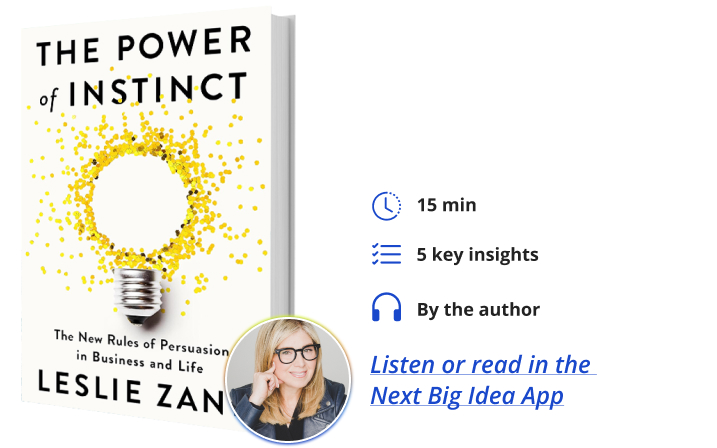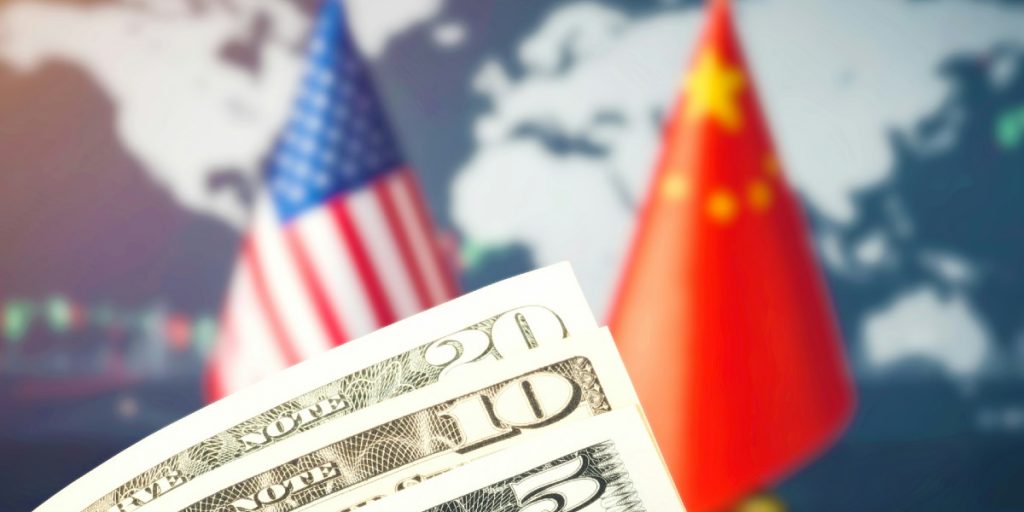Leslie Zane is a behavioral expert and CEO of Triggers, the first female-led brand consultancy that has been using behavioral science to drive business growth for 30 years. She is also an award-winning marketer and a TEDx speaker whose proprietary methodology, “Instinct Marketing,” has been published in Harvard Business Review, Forbes, Newsweek, and Scientific American, among other places.
Below, Leslie shares five key insights from her new book, The Power of Instinct: The New Rules of Persuasion in Business and Life. Listen to the audio version—read by Leslie herself—in the Next Big Idea App.

1. A brand should stand for many things, not just one.
You’ve probably heard the old rule, “A brand should stand for only one thing.” You want to be focused, single-minded, etc. For example, if you’re Volvo, you should stand for safety. But it turns out that standing for just one thing shrinks a brand’s salience. The key to growth is having as many connections as possible. Like a game of Monopoly, the more territory you own, the better.
If you were, say, a wildly successful country artist with hugely popular albums, conventional wisdom would tell you to stick with writing and performing country songs. After all, you don’t want to turn off your loyal audience. What if they don’t receive your new sound well? Stick to what you know!
Well, Taylor Swift didn’t become one of the most successful artists of all time with a billion-dollar tour in 2023 by sticking to one sound. As she leaned into her own artistic curiosity, she expanded beyond country into pop, dance music, and folk, and with each new association, she has grown her audience and visibility. Swift also invited her fans into her life in an unusual way: we know her challenges, the people who helped her, and those who have not. Our relationship with Swift goes way beyond her music; it feels personal. And as she ventures into new music, she keeps reintroducing her past music to new generations. When your brand has these many connections, you create instinctive brand preference, and people are powerless to resist.
2. Familiarity is more powerful than uniqueness, and distinctiveness is best of all.
The traditional rule is that uniqueness is critical for brand success: stand out, differentiate or die, be the purple cow, etc. The rule of uniqueness would tell us that if you have a bottled water brand, you better not use sparkling streams or snow-capped mountains—or even the color blue— on your packaging. It’s cliché, boring, and generic. Except, the brain science is clear: we’re hardwired to crave the familiar, not the unique. We push the unique away.
2020 is a perfect example. During pandemic panic buying, consumers didn’t reach for new brands; they reached for the legacy brands that made them feel comfortable. All that was left on the shelves were the brands you’d never heard of.
“We’re hardwired to crave the familiar, not the unique. We push the unique away.”
So, let’s talk about snow-capped mountains. They have all these inherent associations that already exist in people’s minds without saying them: pure, pristine, eco-friendly, water that comes from the glaciers. Why wouldn’t you want all that associated with your bottled water?
The new rule is that familiarity trumps uniqueness, and distinctiveness is best of all. Look at Aquafina bottled water. They took a snow-capped mountain and rendered it in a stylized, abstract design with a sharp peak and orange sunrise. Distinctiveness enables your brand’s messaging to take a ride on what’s already stored in your customers’ heads. That’s the key to driving decision-making faster and more efficiently.
3. The root cause of slowed growth is often negative associations you can’t see.
The traditional thinking in business is that when a brand stagnates, an external force must be at play: a sluggish economy or an aggressive competitor. But nine times out of ten, the real culprit is much closer to home: negative associations about the brand are growing inside prospective users’ minds.
Think of a brand as a seed you plant in people’s minds. As you feed it positive associations, the seed sprouts, spreading its roots, and if you treat it right, it turns into a full-grown tree. But when negative associations infiltrate your tree, growth slows or declines. This is what happened to McDonald’s a few years back.
Videos showing pink slime in McDonald’s chicken nuggets and food that doesn’t mold had gone viral. They were all a hoax, but that didn’t matter. Negative associations about fake food started growing like an invasive species. But in one of the most remarkable business turnarounds in history, McDonald’s started telling the real story about their food using imagery of freshly cracked eggs, free-range chickens, and sustainably grown potatoes from family farms. The brand began to turn around almost immediately. You can’t get rid of a negative association by talking about it. You have to displace negative associations with positive ones. If you don’t, they will consume your tree.
4. Your prospective customer is more valuable than your core. In fact, your core customer is a trap.
The traditional rule of marketing is that you should spend all your time cultivating loyalty with existing customers. After all, it’s easier and faster to get growth from the people who already buy from you. In a recent Gartner survey, 75 percent of Chief Marketing Officers said they would focus their marketing efforts on selling existing products to customers.
Unfortunately, this rule is another myth. Your core customer is a trap. First, research shows that most people buy multiple brands, and there is churn in every franchise. If you’re not aggressively bringing in new customers, you have a serious leaky bucket problem, and growth will falter.
“Only prospective customers can reveal the negative associations holding them back from buying your brand.”
Second, your core customer is probably already maxed out. How much more shampoo can you sell to a person who is already washing their hair once a day?
Third, your core customer can’t tell you what you need to do to evolve. Only prospective customers can reveal the negative associations holding them back from buying your brand.
The Core Customer Trap is at the heart of many a brand demise—from Sears and Toys R Us to Brooks Brothers and Bed Bath and Beyond. When you’re only focused on the people who already use your brand, you stop improving and evolving. As William Burroughs said, When you stop growing, you start dying.
5. Emotions are fleeting. Only supercharged codes and cues stick.
Sometime in the early 2000s, behavioral science taught us that consumers make irrational decisions. Which is entirely true. However, when it comes to the world of communication, most people came to the wrong conclusion about this. Their interpretation was that if consumers make “irrational” decisions, then we need to create “emotional” advertising. Make them laugh, make them cry—that’ll bring them to you. But the problem is that emotion is an outcome, not an input. You can’t tell people how to feel. Plus, emotions go in one ear and out the other.
When it comes to communications, the key to growth is using familiar cues and codes that match people’s memories, what we call Growth Triggers. These succinct cognitive shortcuts exist in any of the five senses—verbal, visual, auditory, tactile, or olfactory—and are packed with positive associations. The snow-capped mountain is an Image Trigger. “No one grows ketchup like Heinz” is a Verbal Trigger, as is “climate change.” While emotions are ephemeral, Growth Triggers seep into memory structure because they’re packed with meaning. They’re sticky. Whether you’re trying to get a job, communicate with business buyers, doctors, patients, or even run for office, finding Growth Triggers and latching them onto your brand acts like scaffolding, laying down a network of pathways that keeps your brand growing: large, positive, and distinctive.
We are all marketers. Most of us are trying to grow something: a business, personal brand, a start-up, our ideas, even getting our kids to do their homework. If you want to make faster strides, you must stop trying to persuade people because that comes up against a brick wall. The key to success is working with people’s minds instead of against them.
To listen to the audio version read by author Leslie Zane, download the Next Big Idea App today:






























